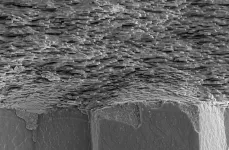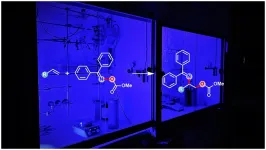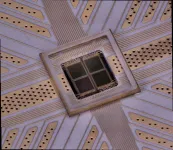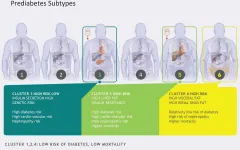Scientists discover how mother-of-pearl self-assembles into a perfect structure
Opposites attract
2021-01-04
(Press-News.org) Mollusks build shells to protect their soft tissues from predators. Nacre, also known as the mother of pearl, has an intricate, highly regular structure that makes it an incredibly strong material. Depending on the species, nacres can reach tens of centimeters in length. No matter the size, each nacre is built from materials deposited by a multitude of single cells at multiple different locations at the same time. How exactly this highly periodic and uniform structure emerges from the initial disorder was unknown until now.
Nacre formation starts uncoordinated with the cells depositing the material simultaneously at different locations. Not surprisingly, the early nacre structure is not very regular. At this point, it is full of defects. "In the very beginning, the layered mineral-organic tissue is full of structural faults that propagate through a number of layers like a helix. In fact, they look like a spiral staircase, having either right-handed or left-handed orientation," says Dr. Igor Zlotnikov, research group leader at the B CUBE - Center for Molecular Bioengineering at TU Dresden. "The role of these defects in forming such a periodic tissue has never been established. On the other hand, the mature nacre is defect-free, with a regular, uniform structure. How could perfection emerge from such disorder?"
The researchers from the Zlotnikov group collaborated with the European Synchrotron Radiation Facility (ESRF) in Grenoble to take a very detailed look at the internal structure of the early and mature nacre. Using synchrotron-based holographic X-ray nano-tomography the researchers could capture the growth of nacre over time. "Nacre is an extremely fine structure, having organic features below 50 nm in size. Beamline ID16A at the ESRF provided us with an unprecedented capability to visualize nacre in three-dimensions," explains Dr. Zlotnikov. "The combination of electron dense and highly periodical inorganic platelets with delicate and slender organic interfaces makes nacre a challenging structure to image. Cryogenic imaging helped us to obtain the resolving power we needed," explains Dr. Pacureanu from the X-ray Nanoprobe group at the ESRF.
The analysis of data was quite a challenge. The researchers developed a segmentation algorithm using neural networks and trained it to separate different layers of nacre. In this way, they were able to follow what happens to the structural defects as nacre grows.
The behavior of structural defects in a growing nacre was surprising. Defects of opposite screw direction were attracted to each other from vast distances. The right-handed and left-handed defects moved through the structure, until they met, and cancelled each other out. These events led to a tissue-wide synchronization. Over time, it allowed the structure to develop into a perfectly regular and defect-free.
Periodic structures similar to nacre are produced by many different animal species. The researchers think that the newly discovered mechanism could drive not only the formation of nacre but also other biogenic structures.
INFORMATION:
Dr. Igor Zlotnikov is a leader of a multidisciplinary group at the B CUBE, TU Dresden. The group studies the interplay between physics of materials and cellular control. The Zlotnikov group implements state-of-the-art techniques from a large spectrum of fields in life and physical sciences to address the fundamental question of how the nature uses thermodynamic principles to generate complex structures. The group is funded by the Federal Ministry of Education and Research (BMBF; grant 03Z22EN11).
Publication:
Maksim Beliaev, Dana Zoellner, Alexandra Pacureanu, Paul Zasklansky, and Igor Zlotnikov: Dynamics of Topological Defects and Structural Synchronization in a Forming Periodic Tissue. Nature Physics (January 2021)
doi: 10.1038/s41567-020-01069-z
B CUBE - Center for Molecular Bioengineering was founded as a Center for Innovation Competence within the initiative "Unternehmen Region" of the German Federal Ministry of Education and Research. It is part of the Center for Molecular and Cellular Bioengineering (CMCB). B CUBE research focuses on the investigation of living structures on a molecular level, translating the ensuing knowledge into innovative methods, materials and technologies.
Web: http://www.tu-dresden.de/bcube
[Attachments] See images for this press release:

ELSE PRESS RELEASES FROM THIS DATE:
2021-01-04
Drones, robots and autonomous systems can transform the natural world in and around cities for people and wildlife.
International research, involving over 170 experts and led by the University of Leeds, assessed the opportunities and challenges that this cutting-edge technology could have for urban nature and green spaces.
The researchers highlighted opportunities to improve how we monitor nature, such as identifying emerging pests and ensuring plants are cared for, and helping people engage with and appreciate the natural world around them.
As robotics, autonomous vehicles and drones become more widely used across cities, pollution and traffic ...
2021-01-04
What The Study Did: In this observational study of 5,256 U.S. nursing home residents with COVID-19, increased age, male sex and impaired cognitive and physical function were independent risk factors for all-cause 30-day mortality.
Authors: Orestis A. Panagiotou, M.D., Ph.D., of the Brown University School of Public Health in Providence, Rhode Island, is the corresponding author.
To access the embargoed study: Visit our For The Media website at this link https://media.jamanetwork.com/
(doi:10.1001/jamainternmed.2020.7968)
Editor's Note: The article includes conflict of interest and funding/support disclosures. Please see the article for additional information, ...
2021-01-04
What The Study Did: The findings of a survey study using data from California suggests the COVID-19 pandemic was associated with increases in self-reported worry about violence for oneself and others, increased firearm acquisition and changes in firearm storage practices.
Authors: Nicole Kravitz-Wirtz, Ph.D., M.P.H., University of California Firearm Violence Research Center and Violence Prevention Research Program, Department of Emergency Medicine, University of California Davis School of Medicine in Sacramento, is the corresponding ...
2021-01-04
Whether in beta-blockers to treat high blood pressure or in natural products: So-called vicinal aminoalcohols are high-quality organic compounds that are found in many everyday products. However, their production is difficult. For a long time, chemists are trying to develop efficient methods of synthesizing them. In their recent study published in the journal Nature Catalysis, scientists led by Prof. Dr. Frank Glorius of Münster University have found a solution for the production of a special variant of aminoalcohols. "The new method helps to study the properties of the substance and to find applications for these ...
2021-01-04
Assembling tiny chips into unique programmable surfaces, Princeton researchers have created a key component toward unlocking a communications band that promises to dramatically increase the amount data wireless systems can transmit.
The programmable surface, called a metasurface, allows engineers to control and focus transmissions in the terahertz band of the electromagnetic spectrum. Terahertz, a frequency range located between microwaves and infrared light, can transit much more data than current, radio-based wireless systems. With fifth generation (5G) communications systems offering speeds 10 to 100 times faster than the previous generation, demand for bandwidth is ever increasing. Facing the emergence of technologies such as self-driving cars and augmented reality ...
2021-01-04
What The Study Did: Changes were assessed in abortions performed and at what gestational age following a Texas order postponing nonmedically necessary surgeries due to the COVID-19 pandemic compared with abortions performed during the same months in 2019.
Authors: Kari White, Ph.D., M.P.H., of the University of Texas at Austin, is the corresponding author.
To access the embargoed study: Visit our For The Media website at this link https://media.jamanetwork.com/
(doi:10.1001/jama.2020.24096)
Editor's Note: The articles includes conflict of interest and funding/support ...
2021-01-04
What The Viewpoint Says: The rapid spread of scientific misinformation on social media platforms throughout the COVID-19 pandemic is discussed in this Viewpoint, which also proposes strategies to counteract its adverse effects including surveillance of digital data and partnering with trusted messengers to engage the public and advance scientifically sound public health measures.
Authors: Raina M. Merchant, M.D., M.S.H.P., of the University of Pennsylvania in Philadelphia, is the corresponding author.
To access the embargoed study: Visit our For The Media website at this link https://media.jamanetwork.com/
(doi:10.1001/jama.2020.24514)
Editor's Note: The ...
2021-01-04
ITHACA, N.Y. - From an observatory high above Chile's Atacama Desert, astronomers have taken a new look at the oldest light in the universe.
Their observations, plus a bit of cosmic geometry, suggest that the universe is 13.77 billion years old - give or take 40 million years. A Cornell University researcher co-authored one of two papers about the findings, which add a fresh twist to an ongoing debate in the astrophysics community.
The new estimate, using data gathered at the National Science Foundation's Atacama Cosmology Telescope (ACT), matches the one provided by the standard ...
2021-01-04
All prediabetes is not the same: in people in the preliminary stages of type 2 diabetes, there are six clearly distinguishable subtypes, which differ in the development of the disease, diabetes risk, and the development of secondary diseases. This is shown in a study by the Institute for Diabetes Research and Metabolic Diseases (IDM) of Helmholtz Zentrum München at the University of Tübingen, Tübingen University Hospital and the German Center for Diabetes Research (DZD). The results have now been published in Nature Medicine. The new classification can help in the future to prevent the manifestation of diabetes ...
2021-01-04
A sugar-binding protein could fuel terrible inflammation and worsen sepsis, a disease that kills more than 270,000 people every year in the US alone, reports a team of researchers led by UConn Health in the 4 January issue of Nature Immunology.
Sepsis is caused mostly by bacterial infections. The immune system runs out of controls and triggers a cytokine storm, a condition in which inflammation-causing proteins flood the blood. Organs may break down, and death often follows.
Other diseases can also cause cytokine storms; medical historians believe cytokine storms were behind the lethality of the ...
LAST 30 PRESS RELEASES:
[Press-News.org] Scientists discover how mother-of-pearl self-assembles into a perfect structure
Opposites attract



